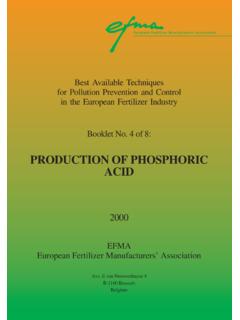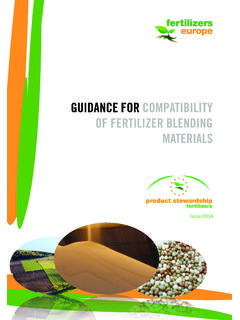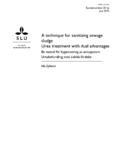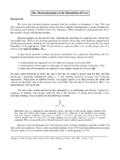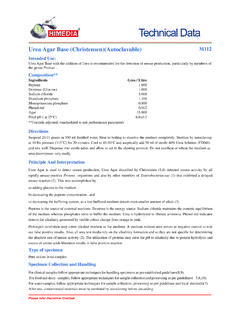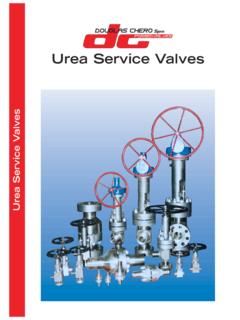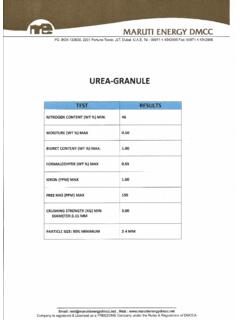Transcription of PRODUCTION OF UREA and UREA AMMONIUM …
1 Best Available Techniquesfor Pollution Prevention and Controlin the European Fertilizer IndustryBooklet No. 5 of 8: PRODUCTION OF UREAandUREA AMMONIUM NITRATE 2000 EFMAE uropean Fertilizer Manufacturers AssociationAve. E van Nieuwenhuyse 4B-1160 BrusselsBelgium Best Available Techniquesfor Pollution Prevention and Controlin the European Fertilizer IndustryBooklet No. 5 of 8: PRODUCTION OF UREAandUREA AMMONIUM NITRATE Copyright 2000 EFMAThis publication has been prepared by member companies of theEuropean Fertilizer Manufacturers Association (EFMA). Neither theAssociation nor any individual member company can accept liabilityfor accident or loss attributable to the use of the information given inthis Booklet. 2 Hydrocarbon feedWaterAirAmmoniaBooklet No.
2 1No. 2 Water AirWaterSulphurWaterPhosphate rockPhosphoric AcidSulphuric AcidNitric AcidNo. 5 UreaUANANCAN NPK(nitrophosphate route) NPK(mixed acid route)K, Mg, S,micronutrientsCalciumcarbonatePhosphat e rockK, Mg, S,micronutrientsNo. 6No. 7No. 8No. 4No. 3 Phosphate rock 3 CONTENTS PREFACE5 DEFINITIONS71. INTRODUCTION82. DESCRIPTION OF urea PRODUCTION urea Plant Installations in Description of BAT PRODUCTION Process Water Sources and Prilling and Feasible and Available Emission Abatement Description of Process Water BAT Treatment Prill Tower Granulator Emissions203. DESCRIPTION OF STORAGE AND TRANSFER Carbon Formaldehyde214. ENVIRONMENTAL Typical Inputs for BAT Synthesis/Prilling Typical Inputs for BAT Melt Granulation PRODUCTION Emissions and Environmental Hazards Associated with Statutory Emission Limit Values (ELVs) Environmental Quality Standards (EQSs)245.
3 EMISSION Parameters and Frequency of General256. MAJOR Corrosion Protection in urea Explosive Gas Hazard Study25 47. OCCUPATIONAL HEALTH & SAFETY268. SUMMARY OF BAT EMISSION LEVELS FOR urea Achievable Emission Levels for New Achievable Emission Levels for Existing Solid Cost of Pollution Control Measures289. urea - AMMONIUM NITRATE (UAN) Overview of UAN Process Description of PRODUCTION Description of Storage and Transfer Equipment Environmental Emission Major Occupational Health & Summary of BAT Emission Levels for UAN Solution Technologies 3210. REFERENCES32 GLOSSARY OF TERMS33 APPENDIX 1 Emission Monitoring in urea and UAN Plants36 APPENDIX 2 General Product Information on urea 40 PREFACE In 1995, the European Fertilizer Manufacturers Association (EFMA) prepared eight Bookletson Best Available Techniques (BAT) in response to the proposed EU Directive on integratedpollution prevention and control (IPPC Directive).
4 These booklets were reviewed andupdated in 1999 by EFMA experts drawn from member companies. They cover the produc-tion processes of the following products:-No. 1 AmmoniaNo. 2 Nitric AcidNo. 3 Sulphuric Acid(updated in collaboration with ESA)No. 4 Phosphoric AcidNo. 5 urea and urea AMMONIUM Nitrate (UAN)No. 6 AMMONIUM Nitrate (AN) and Calcium AMMONIUM Nitrate (CAN)No. 7 NPK Compound Fertilizers by the Nitrophosphate RouteNo. 8 NPK Compound Fertilizers by the Mixed Acid RouteThe Booklets reflect industry perceptions of what techniques are generally considered to befeasible and present achievable emission levels associated with the manufacturing of the prod-ucts listed above. The Booklets do not aim to create an exhaustive list of BAT but they high-light those most widely used and accepted.
5 They have been prepared in order to share knowl-edge about BAT between the fertilizer manufacturers, as well as with the regulatory Booklets use the same definition of BAT as that given in the IPPC Directive 96/61 ECof 1996. BAT covers both the technology used and the management practices necessary tooperate a plant efficiently and safely. The EFMA Booklets focus primarily on the technologi-cal processes, since good management is considered to be independent of the process industry recognises, however, that good operational practices are vital for effective envi-ronmental management and that the principles of Responsible Care should be adhered to byall companies in the fertilizer business. The Booklets give two sets of BAT emission levels:- For existing PRODUCTION units where pollution prevention is usually obtained by revampsor end-of-pipe solutions For new plants where pollution prevention is integrated in the process designThe emission levels refer to emissions during normal operations of typical sized levels may be more appropriate for smaller or larger units and higher emissions mayoccur in start-up and shut-down operations and in 6 Only the more significant types of emissions are covered and the emission levels given inthe Booklets do not include fugitive emissions and emissions due to rainwater.
6 Furthermore,the Booklets do not cover noise, heat emissions and visual emission levels are given both in concentration values (ppm, ) and inload values (emission per tonne of product). It should be noted that there is not necessarily adirect link between the concentration values and the load values. EFMA recommends that thegiven emission levels should be used as reference levels for the establishment of regulatoryauthorisations. Deviations should be allowed as governed by:- Local environmental requirements , given that the global and inter-regional environ-ments are not adversely affected Practicalities and costs of achieving BAT PRODUCTION constraints given by product range, energy source and availability of rawmaterialsIf authorisation is given to exceed these BAT emission levels, the reasons for the deviationshould be documented plants should be given ample time to comply with BAT emission levels and careshould be taken to reflect the technological differences between new and existing plants whenissuing regulatory authorisations, as discussed in these BAT wide variety of methods exist for monitoring emissions.
7 The Booklets provide examplesof methods currently available. The emission levels given in the Booklets are subject to somevariance, depending on the method chosen and the precision of the analysis. It is importantwhen issuing regulatory authorisations, to identify the monitoring method(s) to be in national practices may give rise to differing results as the methods are notinternationally standardised. The given emission levels should not, therefore, be considered asabsolute but as references which are independent of the methods would also advocate a further development for the authorisation of fertilizer plants can be complex, with the integration of several PRODUCTION processes and they canbe located close to other industries.
8 Thus there should be a shift away from authorisation gov-erned by concentration values of single point emission sources. It would be better to definemaximum allowable load values from an entire operation, eg from a total site area. However,this implies that emissions from single units should be allowed to exceed the values in theBAT Booklets, provided that the total load from the whole complex is comparable with thatwhich can be deduced from the BAT Booklets. This approach will enable plant managementto find the most cost-effective environmental solutions and would be to the benefit of ourcommon , it should be emphasised that each individual member company of EFMA isresponsible for deciding how to apply the guiding principles of the , April 2000 7 DEFINITIONS The following definitions are taken from Council directive 96/61/EC of 1996 on IntegratedPollution Prevention and Control.
9 - Best Available Techniques mean the most effective and advanced stage in the develop-ment of activities and their methods of operation which indicate the practical suitability ofparticular techniques for providing, in principle, the basis for emission limit values designedto prevent or, where that is not practicable, generally to reduce emissions and the impact onthe environment as a whole:- Techniques include both the technology used and the way in which the installation isdesigned, built, maintained, operated and decommissioned. Available techniques mean those developed on a scale which allows implementation inthe relevant industrial sector under economically viable conditions, taking into considerationthe costs and advantages, whether or not the techniques are used or produced inside theMember State in question, as long as they are reasonably accessible to the operator.
10 Best means most effective in achieving a high general level of protection for the envi-ronment as a whole. 8 1. INTRODUCTION The application of the Best Available Techniques (BAT) concept as per the EU Directive onIntegrated Pollution Prevention and Control (IPPC) requires emissions into air, water and toland to be prevented. Where this is not practicable the emissions should be minimised by theuse of recovery and recycling techniques with due account being given to the efficient use ofenergy and material Booklet describes the PRODUCTION processes for urea and urea AMMONIUM nitrate(UAN) and the associated emissions. The Booklet does not give a detailed description of allthe different processes in operation or available from technology suppliers.
